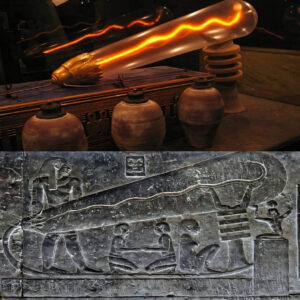Introduction
The renowned relief from the Temple of Hathor in Dendera, Egypt, is one of the most intriguing artifacts for researchers. Dating back to approximately 305–30 BCE, this artwork has sparked much debate regarding the technological capabilities of the ancient Egyptians. Could the images in the relief depict a type of lighting device, similar to a modern electric bulb? This hypothesis becomes even more compelling when compared with other mysterious artifacts like the “Baghdad Battery”—objects that some believe might have been used as a power source. This article will analyze the features of the Hathor Temple relief, relate it to other artifacts, and thereby explore the sophistication of ancient technology.

Analysis of the Hathor Temple Relief
Could the Image Depict a Lighting Device?
In the Hathor Temple relief, there is a long, tubular form resembling an electric bulb, with a coiled shape inside, surrounded by two deities. Some scholars and researchers speculate that this image could depict an ancient form of a light bulb. Although this interpretation is not universally accepted, it opens up new possibilities for viewing the cultural and technological context of the ancient world. Did they actually possess a primitive lighting device, or could this image simply be a religious or symbolic representation?
Comparing the Baghdad Battery – Evidence of Ancient Electrical Technology?
The Baghdad Battery, an artifact from the Parthian era (approximately 150 BCE – 223 CE), is a ceramic jar containing an iron rod and copper tube, which some theorize could generate electricity when filled with an acidic solution like vinegar. While there is no conclusive evidence of its actual use, some hypotheses suggest it might have been used as a low-power energy source, possibly for electrochemical purposes or even to power small devices. Comparing the Baghdad Battery with the relief from Dendera hints that ancient civilizations may have understood rudimentary applications of electricity, though scholars are cautious about making final conclusions.

Theories on Ancient Egyptian Lighting Technology
Lighting Used for Religious Rituals?
Another intriguing theory is that this image may symbolize a lighting device used in mystical rituals. Ancient Egyptians worshipped deities associated with light and frequently held religious ceremonies in dimly lit temples. It is possible they invented or used some form of secret lighting technique to illuminate temple interiors during special rituals. Some scholars theorize that devices like oil lamps or reflective materials might have been used to create a mystical effect.
Lighting for Tomb Construction?
Ancient Egyptians also needed to carry out intricate carving and decorating work in dark tombs where natural light could not reach. The finely detailed engravings found in pyramids and tombs have led researchers to wonder if the Egyptians used some form of technology to illuminate these areas. The hypothesis that they used reflective materials or perhaps other light sources seems plausible, although no direct evidence has been found.

The Significance of Analyzing Ancient Technology
Speculation about the possibility of ancient Egyptian lighting technology carries significance in understanding the development of early civilizations. The idea that they may have achieved technological advancements far beyond our assumptions introduces a new perspective on the knowledge and creativity of our ancestors.
Examining reliefs like the one in Hathor Temple, artifacts such as the Baghdad Battery, and ongoing modern archaeological research could provide valuable insights into the mysterious achievements of the ancient world. Perhaps through more in-depth studies, we will come to understand that ancient people were not as simplistic as often believed—they may have reached a level of scientific and technical sophistication that we are only beginning to uncover.
Conclusion
Although there is still much debate and speculation surrounding the image on the Hathor Temple relief, it is clear that the ancient Egyptians represented a highly inventive and advanced civilization. From constructing architectural wonders like the pyramids to advancing medicine and religious practices, they achieved extraordinary feats. With the progress of modern archaeological science, we may gradually shed light on the mysteries of ancient technology and gain a fuller understanding of their civilization.
